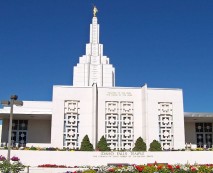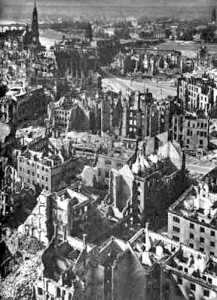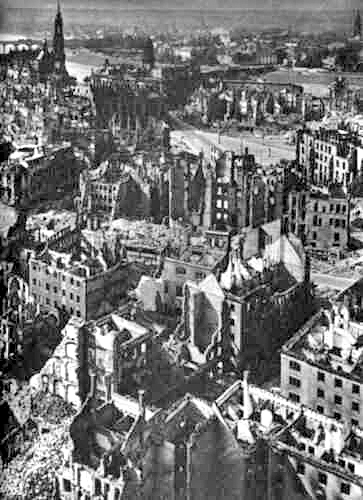George Albert Smith dedicated the Idaho Falls Temple, the eighth temple, in 1945, the same year he assumed the presidency of The Church of Jesus Christ of Latter-day Saints. This was the first temple in Idaho, and the Saints there were overjoyed to have their own temple.

Mormon Temple
Though new temples always bring blessings and joy, World War II left many of Europe’s people destitute, which included many members of the Church. Many cities had been levelled by bombs, and the people were left in rubble and sorrow. Those not killed or taken prisoner were left without homes, food, or clothing, and everyone had lost loved ones. Many of these people understandably turned bitter and cynical, but members of the Church clung to their faith and to one another. Despite the fact that many areas had lost direct contact with the Church, leaders carried on their responsibilities and tried to look out for their wards as best they could. The Church responded immediately to help those who were suffering: both members of its congregations and non-members.
President Smith went to Washington, D.C., to meet with United States President Harry S Truman. President Smith sought permission to send goods to Europe. He recounted his own experience as follows:
“When I called on him, he received me very graciously . . . and I said: ‘I have just come to ascertain from you, Mr. President, what your attitude will be if the Latter-day Saints are prepared to ship food, clothing, and bedding to Europe.’
“He smiled and looked at me, and said: ‘Well, what do you want to ship it over there for? Their money isn’t any good.’
“I said: ‘We don’t want their money.’
“He looked at me and asked: ‘You don’t mean you are going to give it to them?’
 “I said: ‘Of course, we would give it to them. They are our brothers and sisters and are in distress. God has blessed us with a surplus, and we will be glad to send it if we can have the co-operation of the government’” (Arthur R. Bassett, “George Albert Smith: A Living Example of Love,” Tambuli, Sep 1993, 26).
“I said: ‘Of course, we would give it to them. They are our brothers and sisters and are in distress. God has blessed us with a surplus, and we will be glad to send it if we can have the co-operation of the government’” (Arthur R. Bassett, “George Albert Smith: A Living Example of Love,” Tambuli, Sep 1993, 26).
President Thomas S. Monson also told of this event and relays that after listening to President Smith, President Truman responded:
“I like what you plan to do. How long will it take you to assemble the goods you would like to send and prepare them for shipment?”
President Smith responded, “President Truman, the goods are all assembled. One nod from you and the trains will roll, and ships will sail, and those supplies will be on their way.”
[President Monson went on to say,] “It happened exactly that way, with Ezra Taft Benson, then a member of the Quorum of the Twelve, delivering the supplies in behalf of the Church.”
“I was in Zwickau, Germany, several years ago, and an elderly gentleman came up to me and said, “President Monson, I want you to tell President Ezra Taft Benson that the food he brought after the war-food sent by the Church-kept me from starving. It gave me hope for the future.” I was deeply touched as I listened to his expressions of gratitude” (Thomas S. Monson, “Our Brothers’ Keepers,” Ensign, Jun 1998, 33).
In order to assess the needs of the people, and to send them a Church leader to comfort and support them, Elder Ezra Taft Benson travelled to Europe with special documents and credentials from both the First Presidency and the U.S. government. He was assigned special military escorts to enable easier travel and access to the people. He directed relief efforts and brought the Saints in Europe the hope of the gospel and the blessings and love of the Church leaders.
- Mormon Missionaries
While the war had continued, missionary work in Europe was impossible, but with the end of the war, large-scale, international missionary work resumed. As LDS men were discharged from the military, many immediately volunteered for missionary service. By the end of 1946, there were more than 3,000 missionaries in the field once more. In 1947, there were 164 stakes and 1230 wards in the Church.
Twitter •


 Watch a video about the restoration of the gospel on lds.org
Watch a video about the restoration of the gospel on lds.org